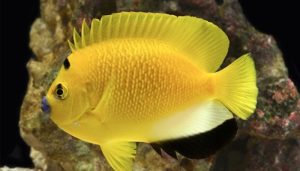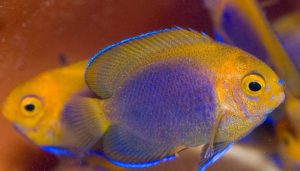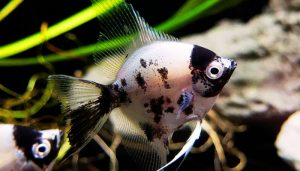How to Breed Angelfish? Breeding of angelfish can be a rewarding and captivating venture for both novice and experienced aquarists alike. Known for their stunning colors and elegant anal fins, angelfish are a popular choice in the aquarium hobby.
However, successfully breeding these fascinating fish requires a solid understanding of their biology, behavior, and habitat needs. In this complete guide for beginners, we will delve into the essential aspects of angelfish spawning, including selecting the right breeding pair, creating an optimal environment, and caring for the fry once they hatch.
Whether you’re looking to enhance your freshwater aquarium with these beautiful fish or explore a new facet of fishkeeping, this guide will equip you with the knowledge and tools needed to embark on your angel fish breeding journey.
Get ready to dive into the world of angelfish reproduction and witness the miracle of life unfold right in your own home aquarium!
Table of Contents
ToggleAre Angelfish Easy to Breed?
Many aquarists wonder if angelfish are generally easy to breed, and while they are relatively straightforward for experienced hobbyists, beginners may face challenges. Angelfish are cichlids, which means they have unique breeding behaviors and requirements.
To successfully breed angelfish, one must ensure the water quality in the aquarium is optimal, as poor conditions can lead to stress and infertility.

A breeding pair should be established in a suitable environment, such as a large tank or a 10-gallon tank, equipped with a heater and a sponge filter to maintain proper conditions.
Additionally, frequent water changes are essential to keep the aquarium water clean and healthy for the angelfish. The ideal temperature for breeding angelfish typically ranges between 78°F and 84°F.
By creating a stress-free environment and monitoring the water quality closely, beginners can increase their chances of successfully breeding angel fish pairs. It’s crucial to be patient and attentive, as breeding may not occur immediately, and several factors can influence the process.
How Many Babies Do Angelfish Usually Have?
When it comes to the number of angelfish fry produced during spawning, it can vary significantly. On average, an angelfish pair can lay anywhere from 200 to 1,000 eggs at one time.
However, not all of these eggs will hatch successfully; some may be infertile or succumb to fungus if not properly cared for. Ensuring that the breeding pair is healthy and well-fed can help improve the hatch rate of angelfish eggs, which are typically laid on flat surfaces like breeding slates or leaves.
Once the eggs are laid, they will take around 2 to 3 days to hatch, depending on water temperature and quality. Experienced aquarists may choose to remove the eggs to a separate tank for better control over the hatching process, while others may allow the angelfish parents to raise their fry.
Regardless of the approach, understanding the average number of fry produced will help aquarists prepare for raising juvenile angelfish once they become free swimming.
What Is the Breeding Behavior of Angelfish?
The breeding behavior of angelfish is both interesting and complex. During the breeding process, a male angelfish will court a female by displaying his fins and swimming around her in a gentle manner.
The pair will engage in a ritual that involves cleaning the spawning site, which can be a breeding slate or a flat rock, to prepare for egg-laying. Once the site is ready, the female angelfish will lay eggs, while the male fertilizes them, ensuring a higher chance of successful hatching.
This nurturing behavior continues as the angelfish parents will guard the eggs from potential threats, such as other fish in a community tank. It’s important to note that angelfish are known for their protective nature, often displaying aggression toward other new tank mates during spawning.
Understanding this behavior is vital for any aquarist looking to breed angelfish successfully, as ensuring the right environment allows the breeding pair to thrive and raise their brood effectively.
Breeding of Angelfish (Step-by-Step)
How to Breed Angelfish? Breeding angelfish involves several crucial steps to ensure a successful outcome. Firstly, it’s essential to choose a healthy breeding pair, ideally from a local fish store (lfs) or a reputable breeder. Once you have your angelfish pair, place them in a suitable breeding tank.
A 10-gallon tank with a heater, sponge filter, and breeding slate for egg-laying is an excellent choice. Next, monitor the water quality closely and perform frequent water changes to keep the conditions optimal.
During the breeding process, observe the pair as they exhibit courtship behavior. Once the female lays her eggs, it’s important to watch for any signs of fungus on the eggs. If necessary, adding methylene blue can help prevent fungal growth.
After a few days, the eggs will hatch into angelfish fry. At this point, you can either allow the parents to care for their young or remove the fry to a separate aquarium to hatch and raise them artificially. By following these steps, aquarists can successfully breed angelfish and enjoy watching their fry grow.
When to Remove Angelfish Fry from Parents?
Knowing when to remove angelfish fry from their parents is crucial for successful raising the eggs. Typically, angelfish fry become free swimming about 5 to 7 days after hatching.
At this stage, they start to explore their surroundings and search for food. If you choose to keep the fry with their parents, allow them to remain for a few weeks, as the angelfish parents will often help protect and nurture the fry during this period.
However, if you decide to separate the fry for artificial raising, it’s best to do so once they are free swimming and have started to develop their yolk sacs. The fry can be fed baby brine shrimp or finely crushed flake food to ensure proper growth.
Keeping the fry in a separate aquarium allows for better control over their environment and reduces the risk of cannibalism from the parents. Proper care during this critical stage can lead to strong, healthy juvenile angelfish.
Commonly Asked Questions about Freshwater Angelfish Breeding (FAQs)
What size tank is recommended for breeding angelfish?
A minimum of a 55 gallon tank is recommended for breeding angelfish. This size provides enough space for the pair to establish their territory and for the eggs to develop properly.
How do I prepare the aquarium to house angelfish for breeding?
To prepare the aquarium, ensure it is cycled properly and has clean water conditions. Include breeding tubes or flat surfaces where the angelfish can lay their eggs. It is also beneficial to include an air stone to maintain oxygen levels.
How can I identify when my angelfish are ready to breed?
Signs that your first angelfish are ready to breed include increased activity, pairing behavior, and the female developing a rounded belly. Additionally, you may notice the pectoral fins of the male becoming more prominent as they prepare for mating.
What should I do after the angelfish lay their eggs?
After the angelfish lay their eggs, you should keep the eggs in the tank and monitor them. Ensure that the water quality is optimal, and consider using a hatchery or breeding net to protect the eggs from potential threats.
How long does it take for angelfish eggs to hatch?
Angelfish eggs typically take about 2 to 3 days to hatch, depending on the water temperature and conditions. During this time, it is crucial to keep the environment stable and free from disturbances.
What should I feed my angelfish once the eggs hatch?
Once the eggs hatch, you should start feeding the small angelfish two times a day with live foods like newly hatched brine shrimp or specially formulated foods like Hikari First Bites. This ensures they receive the necessary nutrients for healthy growth.
How can I identify and remove dead eggs from the batch?
Dead eggs are typically translucent and may appear to have a cloudy look. It’s important to remove these dead eggs promptly to prevent fungal infections that can harm the healthy eggs. You can use a siphon or a small net for this task.
Is it necessary to separate the fry from the parents after they hatch?
It is not always necessary to separate the fry from the parents, but doing so can reduce stress and competition for food. If you choose to separate them, make sure to provide a suitable grow-out tank with plenty of space and appropriate conditions.
What are the common issues that can arise during angelfish breeding?
Common issues during angel fish breeding include deformity in fry, dead eggs, and aggressive behavior from the parents. It’s crucial to monitor the breeding process closely and be prepared to intervene if necessary.
Can I use a divider in the tank for breeding angelfish?
Yes, using a divider can help manage breeding male and female pairs, especially if you have multiple angelfish in the same tank. This allows you to separate one angelfish from the other while still allowing them to see each other, which can stimulate breeding behavior without direct aggression.
Conclusion
In conclusion, breeding angelfish can be a fulfilling experience for beginners and seasoned aquarists alike. By understanding the needs and behaviors of angelfish, including creating a suitable environment and monitoring water quality, you can successfully breed and raise angelfish fry. Whether you choose to allow the angelfish parents to care for their young or take a more hands-on approach, the rewards of watching these beautiful creatures grow are immeasurable. As you embark on this journey of breeding angelfish, remember to be patient, attentive, and prepared for the joys and challenges that come with raising these magnificent fish.
Recommended posts
- What Do Angelfish Eat? The Best Angelfish Food Choices
- Angelfish Tank Size Guide – Ideal Space for Your Fish
- Male vs Female Angelfish: Spotting the Differences Like a Pro
- Angelfish Egg Stages & Hatching Process: (Exclusive Guide)
- Techniques for Sexing Angelfish – How to Tell Gender with Ease
- Angelfish pH Levels: Best Water Conditions for Healthy Fish
- The Complete Guide to Angelfish Tank Set up and Breeding Tips
- Peruvian Altum Angel fish Care Guide – Habitat & Tank Setup
- Angelfish Mating vs. Fighting: Key Signs to Watch For
- Angelfish Eggs Hatching Time: How Long It Takes & What to Do
- Angelfish Eggs Turned White? Common Reasons & Prevention
- Angelfish Fry Stages: From Egg to Juvenile




